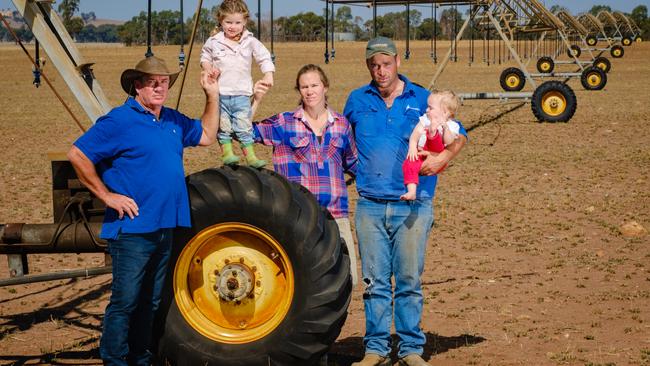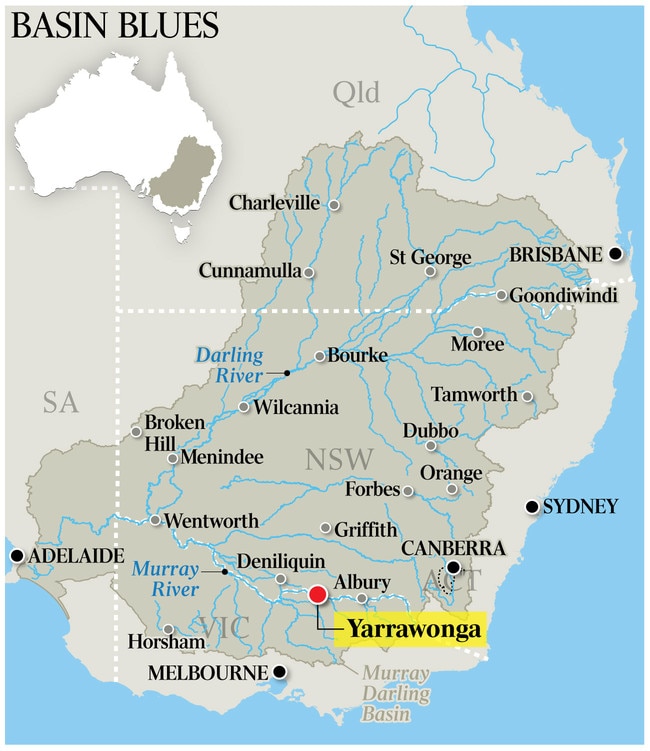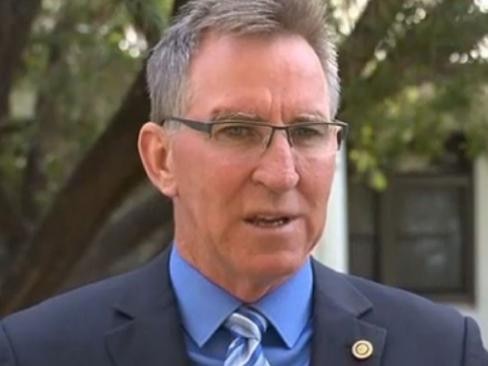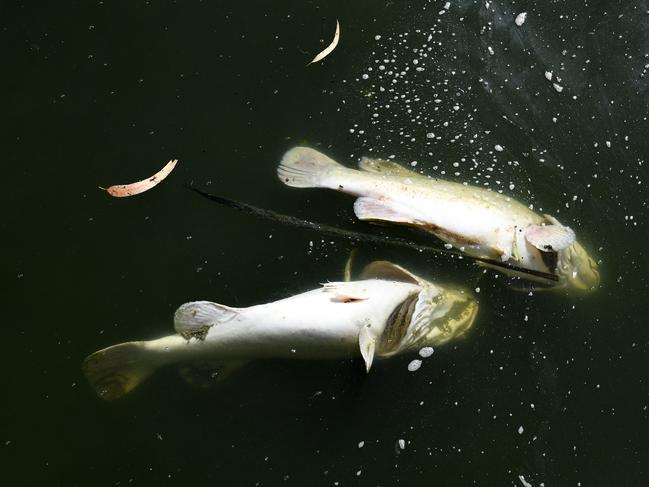Thirsty soil, hard politics
Farmers cry “dry’’ but may lack the clout to change the Murray-Darling Basin Plan.

Chris Brooks grew up on a farm on the Murray River just downstream from the Victorian town of Yarrawonga, but on the other side — in NSW. His grandparents had owned it, running it during the days when state and federal governments encouraged irrigation farming as a nation-building exercise to make a food bowl out of the dry interior.
After a successful career as a grain trader, rising to chief executive of the Australian operation of commodities group Glencore, in 2012 Brooks moved back to take over that family farm, Brooklands. He grew wheat, canola and corn and raised lambs, and initially did quite well by it.
That was just as the federal government and South Australia, Victoria, NSW, Queensland and the ACT agreed on the Murray-Darling Basin Plan, which set a program to reduce the amount of water available for irrigation to restore it to the rivers for environmental flows.
“It was a nice, profitable little farm until the Murray Darling Basin Authority decided to take the water away,” Brooks says.
Now, with water allocations for irrigation farmers running at zero or only a trickle, and water on the tradeable spot market costing $500 to $550 a megalitre, which is about five to 10 times what it was in good times, some crops are just not worth growing. The rice harvest is nearly finished, and it’s estimated the crop will be 50,000 tonnes, or less than a tenth of last year’s, and worth about $300 million less than the average in recent years.
Apart from a handful of farmers who got earlier allocations of water at low prices and kept them for this season, there is no way the rest could make a profit on rice at those water prices. The situation is so bad that only one in 10 rice farmers is growing rice; the president of the Ricegrowers Association of Australia, Jeremy Morton, is one of the rice farmers who isn’t.
“If you had to buy that water, you would lose money — and plenty of it,” he says.
The regional economic and social impact is enormous.
“Farmers’ income is going to be significantly down, and it is going to go through the economy,” he says.
A fundamental factor in the complex equation of water in the Murray-Darling system is a terrible drought. But a lot of people in communities along the rivers are angry at state and federal governments for depriving farmers, through the Basin Plan, of what water they would have otherwise had. The Basin Plan, signed into law by Julia Gillard in 2012 with bipartisan support, aims to progressively restore large amounts of water to the river system for its health by 2024.
It calls for a combination of buying back water licences from irrigators and infrastructure improvements that would mean less water is used for the same effect in irrigation.
Last week, the federal government said it hoped to take even more water off farmers.
Agriculture and Water Resources Minister David Littleproud announced a suite of measures in response to recommendations in a report prepared by University of Melbourne scientist Rob Vertessy on the causes behind, and potential cures for, the vast amount of fish deaths in the Darling River last summer.
As part of the $70 million plan, the federal and NSW governments will encourage big agribusinesses to sell to them their special A-class water licences that allow them to suck up water from the rivers even during environmental flows, largely negating them.
Murray-Darling Basin Authority chief executive Phillip Glyde tells Inquirer the drought, and the graphic fish kills, have had the effect of widening the political rift between irrigators and environmentalists, with angry activists from both sides using them to fight their corner.
Some of the farmers blame the Basin Plan and the MDBA’s river management for the fish kills, blaming them on too much water being sent downstream too early; the green movement says they show more water needs to be taken away from farmers for the health of the rivers.
“What we are witnessing at the moment is re-prosecuting the issue, as you should when you get the chance,” Glyde says.
“The clarion call has been the fish kills.”
The Vertessy report found a combination of short-term climatic factors, including a heatwave that caused algal blooms, followed by a cold snap that killed them, thereby depriving the fish of oxygen. At the same time, severe winds swirled up the different water temperatures at various depths.
But Vertessy found the medium-term problem was drought and the long-term problem over-allocation of water. He made a variety of recommendations to accelerate the Basin Plan and restore more environmental flows to the river, and Littleproud has accepted those that involve the federal government.
But to Brooks and many others, it’s all politically motivated, the intention being to retain the urban pro-environment vote, particularly in the state at the end of the line.
“This government is forging ahead to take all this water from the Murray River to flow out to South Australia and the ocean,” Brooks says.
“They only want the Senate votes from South Australia.”

Brooks, along with many other locals around the rivers, thinks the MDBA has managed the rivers badly, wasting water by flooding a state forest and borrowing access to leaky pipes to get a big flow down to a reservoir feeding South Australia just to meet quotas for that state.
The authority concedes there was a significant loss of water, but says it was the only way to get the job done and keep Adelaide and other communities in that state from drying up.
Now Brooks, some other farmers and scores of members of the community in his neck of the Murray have had enough, and are going to make life hell for the federal government in their turf at the federal election.
Brooks is chairman of a new local lobby group, Voices for Farrer, and has raised $200,000 so far to support Albury Mayor Kevin Mack’s bid to run as an independent in the seat of Farrer against Liberal incumbent Sussan Ley.

Against Labor, Ley’s margin is overwhelming, but against a strong, well-known conservative independent such as Mack, it’s a venture into the politically unknown.
Water is the central issue on which Mack is running — he is calling for a royal commission into the Basin Plan, and for the plan to be “paused” until its completion.
“Pause” is code for freezing any further water buybacks from farmers for environmental flows — and, in fact, Mack wants to reverse the process.
“I am in favour of returning allocations to the farmers, because they need to produce to have a strong region,” he tells Inquirer.
Quite significantly, the Shooters, Fishers and Farmers Party that took western NSW by storm at last month’s state election, winning three lower-house seats and two in the upper house, is not going to run a candidate in Farrer and is putting at least its moral support behind Mack. That party, like Mack, supports a pause in the Basin Plan.
The power of water as a political rallying cry in the regions is extraordinary. On Tuesday, Brooks and his followers, under the auspices of Southern Riverina Irrigators, of which he is also chairman, mustered 1200 farmers and community supporters for a rally in Albury, reinforced by 147 trucks.
Under the banner “Pause the Plan”, the protesters cheered wildly as Brooks told them:
“We want our water back and we want all parties to know we are going to fight for it.”
At the same rally, Brooks’s daughter Carly Marriott told the “water policy megalomaniacs” to “listen up”.
“I grow food so that you and other deserving Australians have a reliable source of sustenance,” she declared.
Ley had the pluck to show up at the rally and asked to speak. She was constantly heckled and harassed as she told the crowd the government felt the region’s pain and that she fought for its water every day. Littleproud has said categorically he won’t pause the plan, and Labor’s water spokesman, Tony Burke, has vowed a Labor government would take it further.
The water issue is, in fact, creating a big rift in the farming community. The peak lobby group, the National Farmers Federation, believes that to try to pause or change the Basin Plan would be political suicide for farmers and rural communities.
“We support the plan — it took a significant amount of effort to get in place, involving six governments,” NFF chief executive Tony Mahar tells Inquirer.
“Now a combination of factors including the drought is producing anxiety and frustration within the Murray-Darling region,” Mahar says.
“We think we need to work within the confines of the plan to address those problems, it’s the only way.”
Mahar says there had been 35 reviews of the plan, of which 14 had been independent.
“How many reviews do we want? It will be paralysis by review,” he contends.
Many farmers believe that although the plan has its flaws, the political reality is that it provides certainty. Chris Morshead is a fourth generation farmer in charge of irrigation operations on 1000ha near Griffith in NSW, under the company name Amberley Pastoral. He grows rice, cotton and, for the first time, corn, which turned out to “be a bit of a failure.”
“We have repositioned ourselves to operate within the Basin Plan as it is,” Morshead says.
“I would like to see it implemented in full and on time, because we know the beast we are dealing with.”

The problem with pausing or tinkering with the plan, he says, is that it would open up a political free-for-all, leading to a victory for the green movement rather than the farmers.
“We don’t have the numbers and we don’t have many allies,” Morshead concedes.
“I cannot combat images of a river of dead fish.”
-
Low oxygen, no escape for fish in Menindee Lakes
The Menindee Lakes are an ideal nursery habitat. High-flow events in 2012 and 2016, combined with the use of commonwealthenvironmental water, connected the river system and created good conditions for significant fish spawning, recruitment, growthand dispersal into the Menindee Lakes.
By the end of 2018, high fish biomass from the recruitment events, releases of water from the lakes by NSW, and the inabilityof fish to move due to the restriction of weirs, resulted in the aggregation of fish populations in the weir pools of theMenindee Main Weir and Weir 32. Hot conditions and low flows resulted in significant algal blooms in Lake Pamamaroo, the weirpools of the Menindee Main Weir and Weir 32.
The combination of hot conditions, low flows and significant algal blooms caused the weir pools to stratify. High fish numbersand algal biomass became concentrated in the surface waters of the weir pools, and hypoxic conditions developed in the bottomwaters.
Sudden reductions in air temperature and increased wind associated with storms caused the weir pools to suddenly destratify,resulting in low oxygen throughout the water column and no escape for the fish. This was the primary cause of the fish deaths.
Source: Vertessy report on fish deaths in the lower Darling

